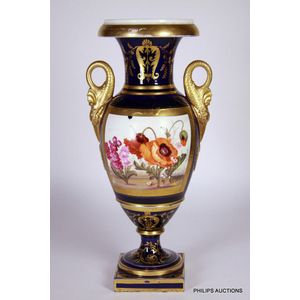Victorian Sterling Silver Trophy with Soldier Finial and Inscription
You must be a subscriber, and be logged in to view price and dealer details.
Subscribe Now to view actual auction price for this item
When you subscribe, you have the option of setting the currency in which to display prices to $Au, $US, $NZ or Stg.
- Victorian Period - The Victorian period of furniture and decorative arts design covers the reign of Queen Victoria from 1837 to 1901. There was not one dominant style of furniture in the Victorian period. Designers used and modified many historical styles such as Gothic, Tudor, Elizabethan, English Rococo, Neoclassical and others, although use of some styles, such as English Rococo and Gothic tended to dominate the furniture manufacture of the period.
The Victorian period was preceded by the Regency and William IV periods, and followed by the Edwardian period, named for Edward VII (1841 ? 1910) who was King of the United Kingdom and the British Dominions and Emperor of India for the brief period from 1901 until his death in 1910. - Vermeil - Gold vermeil is sterling silver (.925 silver) plated with gold. The process originated in France around 1750. The technique was called fire gilding. Jewellery makers applied mercury and gold to the silver and exposed the metal to extreme heat. The heat caused the mercury to vaporize and the layer of gold to adhere to the silver. The qualify as vermeil, the gold layer with which the silver is plated must be at least 10-carat gold
The mercury vapours generated by the heat caused many artisans to become blind, and France made this process illegal in the 1800s. Modern gold vermeil is usually created using an electrolytic process, which is much safer than fire gilding yet produces a similar result.
Vermeil is usually found in jewellery and watches, and occasionally in dinnerware.
In the White House, the residence of the President of the United States, there is a Vermeil Room sometimes called the "Gold Room," which houses the collection of vermeil bequeathed to the White House in 1956 by Mrs. Margaret Thompson Biddle. The Vermeil Room serves as a display room and, for formal occasions, as a ladies sitting room. - Angell Family of Silversmiths - There were a number of members of the Angell family who were silversmiths, commencing with Joseph Angell I (also expressed as Joseph Angell, Senior), and his brothers John Angell and Abraham Angell.
On the retirement of Joseph Angell I in 1948, from what had become the leading London silverware workshop, the business was taken over by his son, Joseph Angell II (also expressed as Joseph Angell, Junior), (1815 - 1891).
Joseph Angell II exhibited at the at the 1851 Great Exhibition, the 1853 New York Exhibition, and the 1862 International Exhibition winning medals at each event.
His career is marked by the rich silver items crafted and decorated with chiseling, reliefs and enamels, including trays, tea and coffee sets, jugs, centrepieces and vases
The Victoria and Albert Museum in London holds a number of silver objects by Jospeh Angell II. - Sterling Silver - Sterling silver is a mixture of 92.5% pure silver and 7.5% of another metal, usually copper. Fine silver is 99.9% pure silver, and is relatively soft and the addition of the very small amount of copper gives the metal enough strength and hardness to be worked into jewellery, decorative and household objects.
- Hallmarks - A mark stamped on articles of precious metals in Britain, since the 14th century, certifying their purity. It derives its name from the Guild Hall of the Goldsmiths' Company, who recieved its Charter in 1327 giving it the power to assay (test the purity) and mark articles of gold and silver.
The hallmark will consist of several marks, including the:
- silver standard mark, indicating the purity of the metal. Sterling silver is .925 pure silver.
- the city mark indicating the city in which it was assayed eg London, Birmingham, York etc.
- the date mark, usually a letter of the alphabet in a particular font and case,
- a duty mark, indicating whether duty had been paid to the crown, and only in use from 1784 to 1890
The piece may include an additional mark, the maker's mark, although not forming part of the hallmark, will be located in the vicinity of the hallmarks.
Sometimes silver plated items will bear faux hallmarks, often confusing those not familiar with silver markings. - Finial - An architectural decoration, found on the upper parts of of an object. On furniture they are usually found on pediments, canopies and shelf supports. On smaller ceramic or silver items, such as spoons, they may decorate the top of the item itself, or the lid or cover where they provide a useful handle for removal.
Finials have a variety of shapes and forms. They may be urn-shaped, baluster shaped round or spiral, but usually taper into an upper point. Many real life shapes may also be used as finials, such as pineapples, berries, pinecones, buds, lotus and acorns. Sometimes animals such as a lion are depicted, or fish and dolphins.
This item has been included into following indexes:
Visually similar items

A George III sterling silver richly embossed pepperette London 1799, 8.5 cm

1889-90 Cricket Cup, silver plated cup with lid decorated with cricketer, engraved on front 'Dark's Challenge Cup, won by Galatea Cricket Club 1889-90', and on other side 'Presented to C.Walker Esq, Ballarat, 1890', 33 cm tall

A Edward VII silver bowl, maker James Dixon & Sons Ltd. Sheffield 1905, circular form with fluting and flower head chased decoration. 484grams. 10 cm high, 16 cm diameter

A Grainger Lee & Co Worcester pedestal vase, circa 1815-20, the elegant Empire style vase with finely moulded dolphin handles and anthemion mounts, with a framed painted plaque of oriental poppies and stocks, upon a cobalt ground richly gilded with borders
